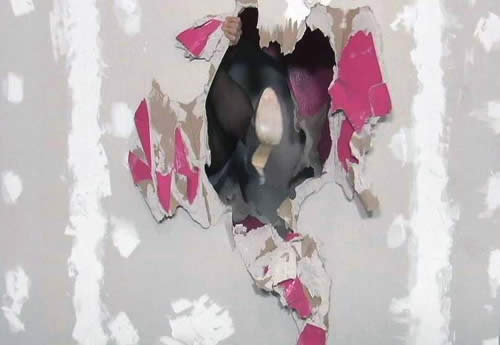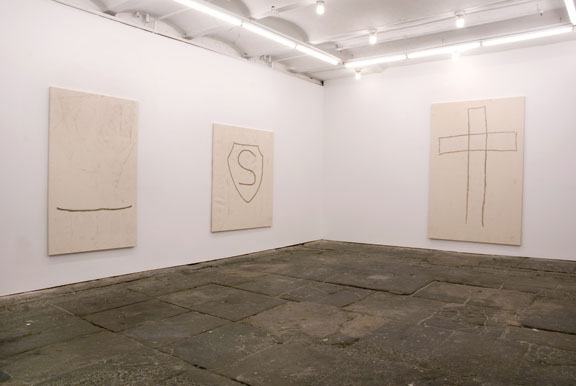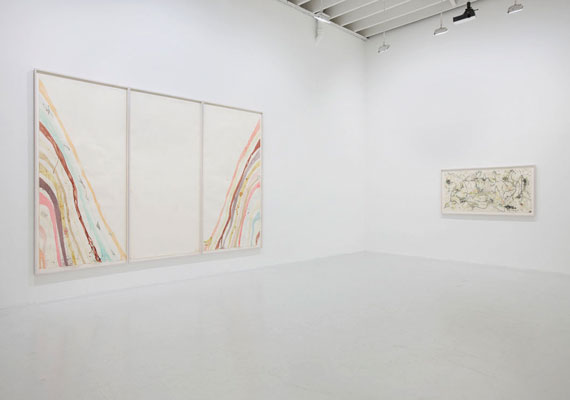This is an archive of the ArtCat Zine, 2007-2009. Please visit our new project, IDIOM.
Recently by Blythe Sheldon

Kate Gilmore
Smith-Stewart - 53 Stanton, New York NY
21 November 2008 - 18 January 2009
Kate Gilmore is a home wrecker. In the four videos on display at her Smith-Stewart debut, she kicks through layers of drywall and attacks furniture and construction materials with a sledgehammer, all while wearing high heels and dresses. As part of the exhibition, Gilmore taped herself at the front of gallery powering through two layers of drywall strewn with hot pink paper. The result of her assault in black heels and a double-breasted dress is a video called Walk This Way, which plays in a claustrophobic space directly to the side of her performance's dusty remnants. We hear the polyphonic sounds of destruction from the other videos simultaneously playing. Between a Hard Place features Gilmore in yellow spike heels, a black dress, stockings and short black gloves, again clawing through layers of gray drywall, this time coordinated with a sheet of yellow wallpaper at the journey's end. The scene recalls Charlotte Perkins Gilman's 19th century short story, The Yellow Wallpaper, about a female protagonist who is diagnosed with a "slight hysterical tendency." As treatment she is confined to her bedroom by her physician husband, where she obsesses over the patterns of the wallpaper and slowly descends into madness. In contrast, Gilmore seems relieved when she takes off her gloves and faces the camera upon reaching the end.
The joy of Gilmore's project is its lack of resolution: is there truly a breakthrough if she set the scene? The other two works continue to question her resolve, both in terms of practical objectives and physical well-being. Across from Between a Hard Place is Down the House, an aerial view of the artist standing on top of a pile of office furniture and plaster blocks splashed in red wet paint. In matching red slip-on sneakers, yellow dress and pink hair ribbon, she wields a sledgehammer to destroy the heap below her, constantly adjusting her balance. As the blocks topple over and the screen fades to black, we still hear her pound the plaster. Higher Horse again finds Gilmore considering ideas of balance and structure when she places herself atop a mountain of cement blocks that two men attempt to dismantle with mallets. We see her build herself a platform to stand upon, only to fall down and climb back up. Her pink tee shirt matches the pink wall covered with veiny, red streaks. Somewhere along the way, she loses a heel.
Gilmore's endurance -- as a sculptor, stylist, and performer -- pays homage to the studio performance tapes of artists like Vito Acconci and Marina Abramovic who, in the early1970s, made work investigating physical limits. Her explicitly gendered characters also echo the feminist narrative of the same era. Whereas Martha Rosler violently demonstrated kitchen utensils in Semiotics of the Kitchen, Gilmore practically swung a wrecking ball through the home. That spiked heel may be more dangerous than you think. Yet for all the theatricality, the artist betrays her background in sculpture with each performance. Her videos are single-take and unrehearsed. The sound of her grunts and breath is real. It's a needed counterpoint to all the artifice. Given the tremendous constraints under which New Yorkers live -- our tiny, overpriced studios, curious roommates, and so on -- an expansion of living space is wish fulfillment. If it takes a little hysteria or high heels, so be it, if it gets the job done.

Schmagoo Paintings
Joe Bradley
CANADA - 55 Chrystie St, New York NY
25 October - 3 December 2008
For Joe Bradley's charming second show at CANADA, the modern world is encapsulated in the images of Superman's "S", the number "23" (possibly recalling Michael Jordan's uniform), a cross and other symbols -- some whole, some broken. The pictures emerge prehistoric, as black grease pencil doodles on unprimed canvases. The first work one encounters upon entering the gallery is a large canvas titled Schmutz Painting, devoid of any marking except a dusting of schmutz -- the Yiddish word for dirt. The title is a play on the exhibition title itself, Schmagoo, which Bradley thought sounded like the name of a Jewish superhero. Not coincidentally, there is schmutz on the five other works in the exhibition as well.
Through inscription, monument and other forms of material remembrance, past symbols and names outlive their time. Look closely, though, and the memories preserved transmogrify. They seem both familiar and obscure. The philosopher Walter Benjamin was riveted by this tension. For him, images and objects possessed an immanent power, and he considered how such power translated over time. He believed this history is collapsed into images, and it was the historian's job to rescue those which would resonate now. Writing from a Marxist perspective, he thought that by recovering and showing them again, the images could take on a kind of revolutionary potential. That potential comes from the viewer's critical distance and recognition. The moment we see a past image in a new form, like a painting, our past perception of the image merges with, and is transformed by, the present. Myths combine with contemporeneous specificities. New possibilities open up for exploring and changing the current tides of culture. Benjamin calls this the shock of the dialectical image. Bradley's painting may not exactly ignite new ways of thinking, but a weird scrawl of Michael Jordan's number is at least amusing. As Bradley explains in the press release, schmagoo is also old slang for heroin, which he uses as "a metaphor for the original creative act. The Word made Flesh. The transmutation of Schmagoo into Alchemical Gold." His vernacular -- childhood heroes, sports icons and associations -- has achieved a redemptive state. The pictures become our contemporary talismans.
Prior to this exhibition, Bradley's best known pieces were wall-mounted figures made up of monochrome canvases, resembling a convocation of Tetris shapes. They challenged the notion that as a minimal installation, these rectangular assortments ought to be read as abstract, both art historically and colloquially. His new work again considers minimalism, but also offers a perverted take on an imagined primitivism. As a whole, the exhibition falls somewhere on the continuum between lightly conceptual and prank. If an archaeologist scrutinized Bradley's work as seriously as he would a cave painting, he would most likely consider our society consumer-driven, shallow and a little silly. Bradley might shrug and laugh at him. The self-effacing tone of the exhibit is, in the end, more exciting than the work itself, though the banality of the paintings grew on me with a second gallery visit. Upon leaving, I felt lighter.

Man Eater
Aurel Schmidt
Deitch Projects - 76 Grand Street, New York NY
4 October - 1 November 2008
There's nothing wild about Man Eater, Aurel Schmidt's debut at Deitch Projects. Here she reinterprets modernist masters in the form of city detritus. Jackson Pollock's Number 8 is recast as Everything Means Nothing To Me, a listless punk assemblage of moist wipes, condoms, dead sparrows, maggots, flies, worms, lipstick, caps to Duane Reade prescriptions, and various brands of cigarettes. Willem de Kooning's Woman And Bicycle becomes Like A Fish Needs A Bicycle, an act of feminist defacement in which the depicted figure's grin is transformed into candy colored dildo lips with cigarette teeth, while her breasts become mice and car deodorizers. While the sexualization of female subjects by certain modernist painters seems to offend Schmidt, what her own work achieves remains unclear. Her drawing ability is undercut by her unfocused vision. The largest work in the exhibition is Schmidt's take on Morris Louis' Alpha-Pi, titled So Damn Pure. Images of bloody Band-Aids, partially-chewed take-out, rainbow M&M-chip cookies, and sardines fill the blocks of color she saturated with urine, beer, and Kool-Aid. By reinserting clear pictures into a form meant to dispense with imagery, and taking her subject matter for her medium, her version appears overstuffed.
Schmidt is not Tony Shafrazi tagging Guernica in 1974, nor is she Valerie Solanas advocating the Society to Cut Up Men. She's merely angsty by comparison. Of her mission, the press release says that Schmidt "sees the progression of Modern Art as chasing a purity she seeks to problematize." She interprets this literally by converting the line of the original brush strokes into trash. In terms of the abstract expressionist paintings she's chosen, purity can have a variety of meanings. She could be referring to the artists' unbridled subjectivity which guides some of these works. Pollock, among others, imagined a beyond behind the canvas, where the physical act of creation became as important as the final work itself. She might also be referring to the relationship between ideology and technique. Abstraction -- freedom from the symbolic and representational baggage of painting -- reflected the spirit of a liberal, post-war market of ideas and commodities, long since in the historical making. We see the techniques and forms of modern painting divested of their political and intellectual significance. Man Eater is charming and rebellious fun, but hopefully her future work will treat these art historical trajectories with the same precision of her lines. The effect is otherwise existential Where's Waldo: What are we searching for?
ZINE
HOME
TIPS / COMMENTS
CATEGORIES
CONTRIBUTORS
- Greg Afinogenov
- B. Blagojevic
- Adda Birnir
- Susannah Edelbaum
- Julie Fishkin
- Paddy Johnson
- Jessica Loudis
- Christopher Reiger
- Andrew Robinson
- Peter J. Russo
- Blythe Sheldon
- S.C.Squibb
- Hrag Vartanian
